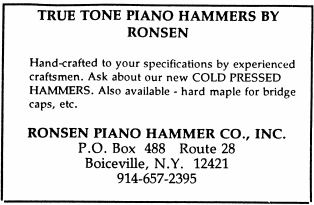Page 2
|
Tech Tip
The other day I went to tune a piano, and the customer complained
about sticking keys in the bass section. It was a grand piano and when
I pulled the action out I noticed that the hammers were changed. About
half of the hammers were scraping on each other. Unfortunately, I left
my hammer file and roto tool in my shop. I had to figure out a way to
fix this problem on the spot because they didn't live close by.
I took a regular pliers that is curved at the top, and squeezed one hammer
felt right on the spot where it was hanging up. Next I squeezed the hammer next
to it, at the spot where it was hitting, and it worked perfectly and quickly.
It took me five minutes to squeeze all the rest of the bass hammers in two spots.
If you try this trick when you're in a bind, make sure you support the hammer
shank by griping the fat part of the hammer with your other hand.
by Paul Eccardt - Chapter President 
|
(minutes - continued from previous page)
He softens the hammers by needling on the opposite side of the hammer with small needling and tests it as he needles, to check the tone. He does not needle at the strike point and does not use any other methods to voice hammers, although he mentioned that other people may use them.
Chris gave an interesting and informative presentation and we thank him for coming from Connecticut. We also thank Steinway for allowing us to use their store and piano for the demonstration.
The meeting ended at 9:15 PM.

|